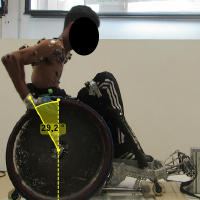Kinematic bidimensional analysis of the propulsion technique in wheelchair rugby athletes

Accepted: 3 March 2020
HTML: 11
All claims expressed in this article are solely those of the authors and do not necessarily represent those of their affiliated organizations, or those of the publisher, the editors and the reviewers. Any product that may be evaluated in this article or claim that may be made by its manufacturer is not guaranteed or endorsed by the publisher.
Wheelchair rugby is a sport ideated for individuals with cervical spinal cord injury (CSCI) which is extremely important for maintaining their neuromuscular abilities and improving their social and psychological wellbeing. However, due to the frequent changes in direction and speed it considerably stresses the players’ upper limbs. 13 athletes have undergone two sports-related tests on an inertial drum bench and several kinematic parameters have been registered. Most athletes use a semi-circular pattern which is considered protective for the upper limb. With increasing speed, range of motion (ROM) increases. Release angles increment and contact angles reduce, displacing the push angle forward to increase speed. Instead, the more anterior late push angle used to increase velocity is a factor which further loads the shoulder joint. However, other factors affecting propulsion technique, such as posture and wheelchair set up should be studied to further reduce loading on the upper limb.
International Wheelchair Rugby Federation. Introduction to wheelchair rugby. Available at: http://www.iwrf.com/resources/iwrf_docs/Introduction-to-Wheelchair-Rugby-2012.pdf. Accessed September 5, 2015
Jackson RW. Sport for the spinal paralysed person. Paraplegia 1987;25:301–4.
Hicks AL, Martin KA, Ditor DS, et al. Long term exercise training in persons with spinal cord injury: effects on strength, arm ergometry performance and psychological well-being. Spinal Cord 2011;41:34-43. DOI: https://doi.org/10.1038/sj.sc.3101389
O’Neil SB, Maguire S. Patient perception of the impact of sporting activity on rehabilitation in a spinal cord injuries unit. Spinal Cord 2004;42,627-630 DOI: https://doi.org/10.1038/sj.sc.3101651
Bayley J, Cochran T, Sledge C. The weight-bearing shoulder. The impingement syndrome in paraplegics. J Bone Joint Surg 1987;69:676-8. DOI: https://doi.org/10.2106/00004623-198769050-00006
Bauerfeind J, Koper M, Weiczorek J, et al. Sports Injuries in Wheelchair rugby –A Pilot Study. J Hum Kinet 2015;48:123-32. DOI: https://doi.org/10.1515/hukin-2015-0098
Morrien F, Taylor JDM, Hettinga TF. Biomechanics in Paralympics: Implications for Performance. Human Kinetics Journals 2016;12:578-89.
Rao SS, Bontrager EL, Gronley JK, et al. Three-Dimensional Kinematics of Wheelchair Propulsion. IEEE Trans Rehabil Eng 1996;4:152–60 DOI: https://doi.org/10.1109/86.536770
OIC onlus (2015), “Progetto Wheelchair Rugby: Miglioramento delle capacità neuromuscolari residue in atleti disabili nella pratica sportiva del rugby in carrozzina”. Available online at: http://community.oiconlus.it/civitasvitae/files/2015/11/Ultimo-progetto-WCR-Masiero-Rugby.pdf
Van der Scheer JW, De Groot S, Veeger RJK, Van der Woude LH. Can a 15-m overground wheelchair sprint be used to assess wheelchair-specific anaerobic work capacity? Med Eng Phys 2014Vol 36, No.4, pag. 432-438. DOI: https://doi.org/10.1016/j.medengphy.2014.01.003
Boninger ML, Koontz AM, Sisto SA,et al. Pushrim biomechanics and injury prevention in spinal cord injury: Reccomendaions based on CULP-SCI investigations J Rehabil Res Dev 2005;42:9-20. DOI: https://doi.org/10.1682/JRRD.2004.08.0103
Haydon DS, Pinder AR, Grimshaw PN, Robertson WSP. Overground Propulsion Kinematics and Acceleration in Elite Wheelchair Rugby. International Int J Sports Physiol Perform 2017:1-23.
Van der Woude LHV, Veeger DJ, Rozendal RH. Seat Height in handrim wheelchair propulsion. J Rehab Res Devel 1989;26:31-50.
Requejo PS, Mulroy SJ, Ruparel P, et al. Relationship Between Hand Contact Angle and Shoulder Loading During Manual Wheelchair Propulsion by Individuals with Paraplegia. Top Spinal Cord Inj Rehabil 2015;21:313-24. DOI: https://doi.org/10.1310/sci2104-313
PAGEPress has chosen to apply the Creative Commons Attribution NonCommercial 4.0 International License (CC BY-NC 4.0) to all manuscripts to be published.


 https://doi.org/10.4081/ejtm.2019.8902
https://doi.org/10.4081/ejtm.2019.8902



